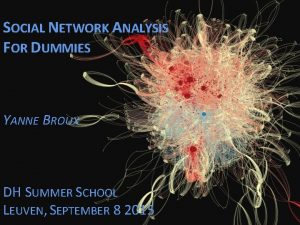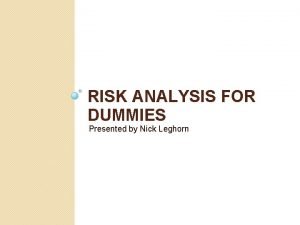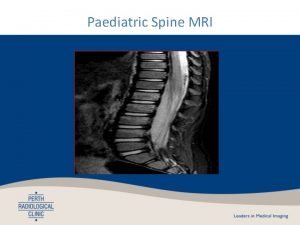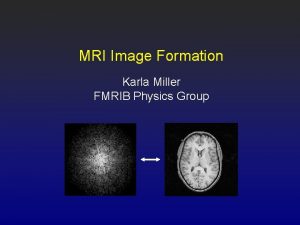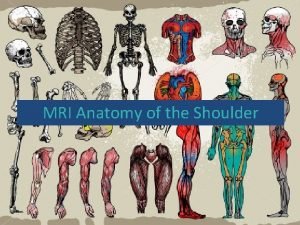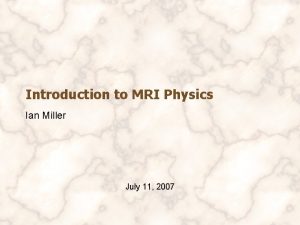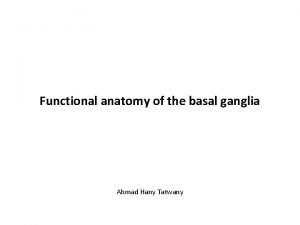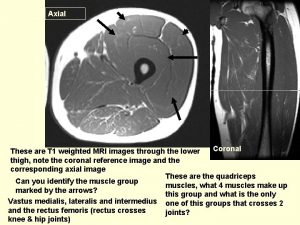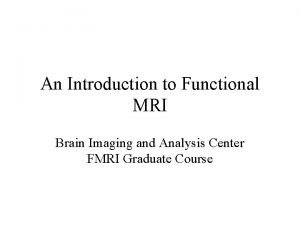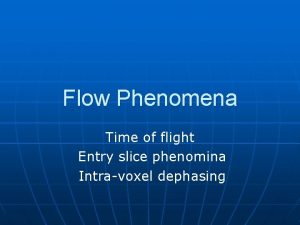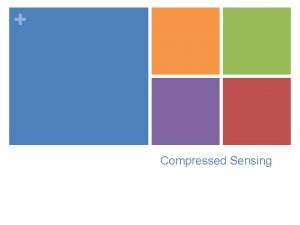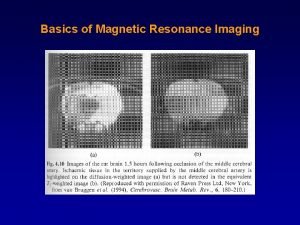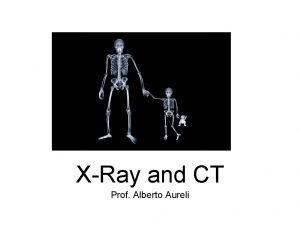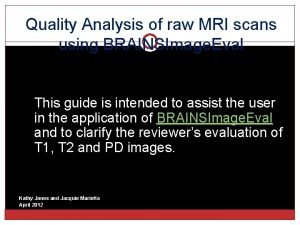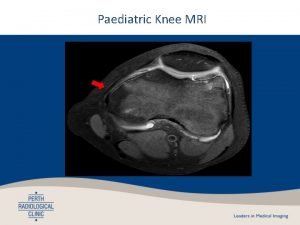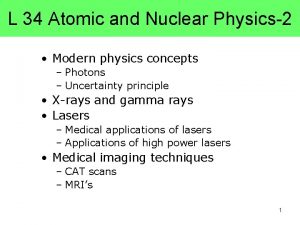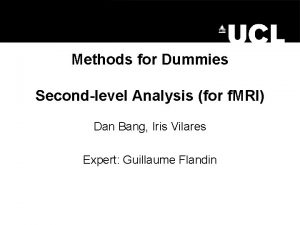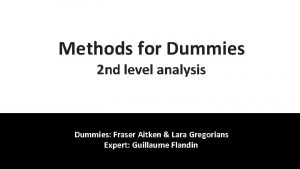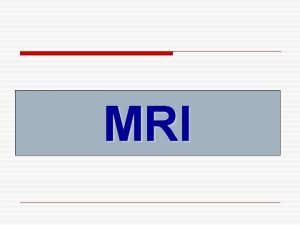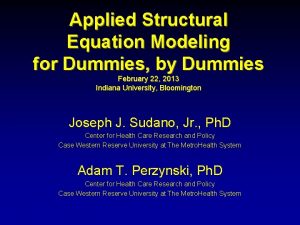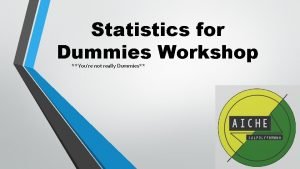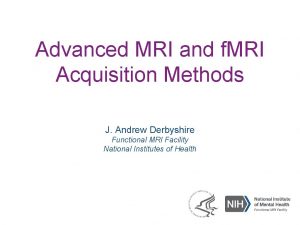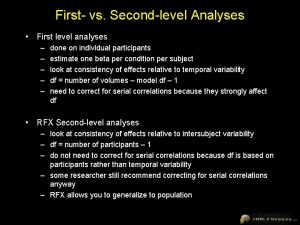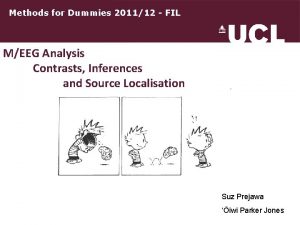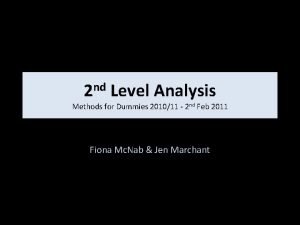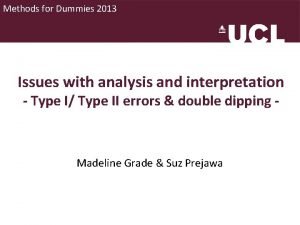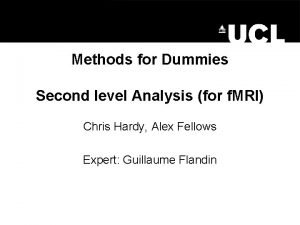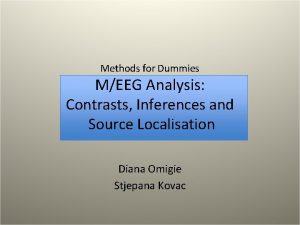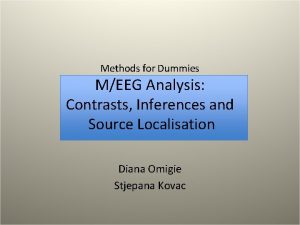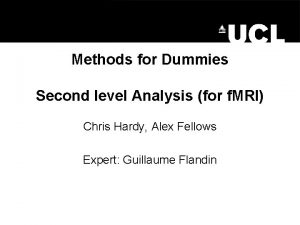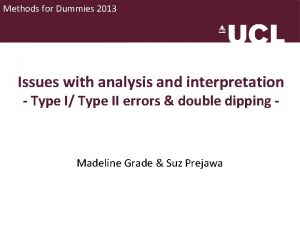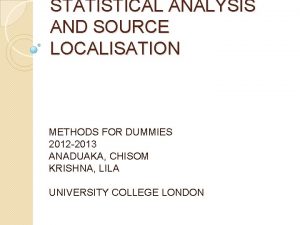Methods for Dummies Secondlevel Analysis for f MRI














































- Slides: 46

Methods for Dummies Second-level Analysis (for f. MRI) Justyna Ekert & Alex Hopkins Expert: Guillaume Flandin

Overview 1. 2. 3. 4. 5. Recap of first-level analysis What is second-level analysis? Fixed versus random effects How do we analyse random effects? Practical demonstration 2

First level Subject N … Subject 2 Subject 1 f. MRI data Design Matrix Contrast Images SPM{t}

Second level analysis • Deals with groups of subjects, e. g. Patients vs. control Brain activity*trait anxiety • which voxels consistently show significant activity within our group • We would also like to be able to generalise our results to non-tested subjects 4

Overview 1. 2. 3. 4. 5. Recap of first-level analysis What is second-level analysis? Fixed versus random effects How do we analyse random effects? Practical demonstration 5

Fixed versus random effects Different assumptions about the source of random variation in voxel activity

Fixed effect One source of variation: measurement error

Fixed effect One source of variation: measurement error

Fixed effects • Only one variation: measurement error (within subject) σw 2 • True response magnitude is fixed. 9

Random effects analysis (RFX) • Synonymous with ‘mixed effects models’. • Assumes our sample is a set of individuals taken at random from the population of interest. • To do this we need to consider the between subject variance, σb 2, as well as σw 2 – and estimate the likely variance of the population from which our sample is derived. 10

Random effect Two sources of variation measurement error Response magnitude Black line – population mean 11

Random effect Two sources of variation measurement error Response magnitude Black line – population mean 12

Random effect Two sources of variation measurement error Response magnitude Subject as a random factor 13

Random effects • Two sources of variation: – Measurement error (within subject) – Response magnitude (between-subject) • Response magnitude is random – each subject/session has random magnitude – population mean is fixed. Mixed-effect analysis

Summary: Fixed vs. mixed effects (from Poldrack, Mumford and Nichol’s ‘Handbook of f. MRI analyses’) 15

Scan more subjects! Because the between-subject variance is greater than the within subject variance, scanning time is best used in scanning more subjects rather than scanning individual subjects for longer. 16

Fixed-effects: We can only say something about our particular group of subjects No generalisation case studies Random-effects: We make inferences about the population from which the subjects were drawn generalisation possible 17

“Mixed effects models should be used whenever data are grouped within certain levels of a population and inferences are to be applied to the entire population. ” - Mumford and Poldrack (2007) 18

19

First level Design Matrix Contrast Images One-sample t-test @ second level Subject N … Subject 1 f. MRI data Second level 20 Generalisability, Random Effects & Population Inference. Holmes & Friston, Neuro. Image, 1998.

Methods for Random Effects Hierarchical • Most accurate method – gold standard • Set up a GLM containing parameters for the effects and variances at both the subject AND group levels, to all be estimated at the same time. • Estimates subject and group statistics via “iterative looping” • Computationally demanding 21

Methods for random effects Summary statistics • 1 st level design for all subjects must be the SAME • Uses the sample means as in the first level analysis • Gives exact same results as hierarchical model (when the within-subject variance is the same for all subjects) • Validity is undermined by presence of extreme outliers. 22

Robustness Summary statistics Hierarchical Model Mixed-effects and f. MRI studies. Friston et al. , Neuro. Image, 2005. 23

Overview 1. 2. 3. 4. 5. Recap of first-level analysis What is second-level analysis? Fixed versus random effects How do we analyse random effects? Practical demonstration 24

Summary Statistics RFX Approach First level Design Matrix Contrast Images One-sample t-test @ second level Subject N … Subject 1 f. MRI data Second level Generalisability, Random Effects & Population Inference. Holmes & Friston, Neuro. Image, 1998.

Summary Statistics RFX Approach Subject 1 f. MRI data Design Matrix efficient One-sample t-test @ second level Contrast Images Easy to do Subject N … Robust ! Generalisability, Random Effects & Population Inference. Holmes & Friston, Neuro. Image, 1998.

Overview of today’s talk 1. 2. 3. 4. 5. 6. Recap of first-level analysis What is second-level analysis? Fixed versus random effects How do we analyse random effects? Practical demonstration Questions 27

Buttonpressing 28

29

Set-up options • Directory • To write SPM. mat to • Design • Scans: select con. *img from 1 st level • Several design options: • 1 sample t-test • 2 sample t-test • Paired t-test • Multiple regression • 1 way ANOVA • Full or flexible factorial (for > 1 way ANOVAs – use FLEXIBLE FACTORIAL to include subjects as a 30 random factor!)

Example flexible factorial model for a 2 x 2 within subjects ANOVA • Define factors: e. g. subject, conditions • Select scans for each condition per subject • Specify main effects and interactions of interest • Factors: • “Independence” – whether the errors are independent between factor levels • “Variance” – whether the error variances are equal between factor levels 31

• • • Include ‘subject’ as a factor to account for random variance between subjects. Independence: yes (different individuals) Variance: equal (subjects from same population Specify factor 1 (e. g. odour vs no odour) Independence: no (assume different factor levels are correlated within a subject) Variance: equal (do not expect variances between levels of within subjects factors) Specify factor 2 (e. g. faces vs objects) Independence: no (assume different factor levels are correlated within a subject) Variance: equal (do not expect variances between levels of within subjects factors) 32

• Each subject should have a section with ‘Scans’ and ‘Conditions’ (e. g. 4 subjects) • Input images (con images) for each subject under ‘Scans’ – each subject should have 4 scans • Factor matrix should be specified in ‘Conditions’ • E. g. Factor A (2 levels: Odour vs No Odour), and Factor B (2 levels: Flowers vs Objects) = A 1 A 2 B 1 B 2 • Enter into Conditions: 1 1; 1 2; 2 1; 2 2 • Subjects is a ‘special’ factor – no need to specify factor levels 33

• Main effects and interactions • Main effects: e. g. to investigate main effect of the ‘subjects’ factor – enter 1 • Interaction effects: e. g. to investigate ALL main effects and interactions of experimental conditions – enter 2 3 34

• Covariates • Input covariates (e. g. behavioural ratings) & nuisance variables here • 1 value per con*. img • Enter per subject, in the order of conditions • Masking • Specifies voxels within image which are to be assessed • Implicit is default • Mostly for VBM/PET • Global calculation/normalisation • Mostly for VBM/PET 35

Specify 2 nd level Set-Up ↓ Save 2 nd level Set-Up (File > save batch) ↓ Run analysis ↓ Look at the RESULTS 36

Results 37

e. g. 2 nd level 1 -sample t-test • Select t-contrast • Define new contrast • c = +1 (e. g. A>B) • c = -1 (e. g. B>A) 38

Select options for displaying results: • Correct for multiple comparisons – FWE/FDR • Set p value to 1 first • Then to 0. 05, or better, 0. 001 • Extent threshold voxels: minimum cluster size (k = 20) 39

40

41

42

Suggestions • Always also check results at p = 1 uncorrected (you should see a full brain activation -> if not there is a problem) • If no full brain: probably one (or more) participants had a wrong realignment/normalization! 43

One wrongly aligned subject can take away any possible group-level effects! If just 1 subject doesn’t have a certain voxel, that the voxel gets discarded at the 2 nd level for all. 44

Summary • For f. MRI data, usually preferable to use RFX analysis, not FFX • Hierarchical models provide gold standard for RFX , BUT computationally intensive • Summary statistics = robust method for RFX group analysis 45

Resources • • • Previous Mf. D slides Glascher, J. & Gitelman, D. (2008) Contrast weights in flexible factorial design with multiple groups of subjects. Slides from Guillaume Flandin’s talk in Zurich, Feb 2014 Mumford, J. A. , & Poldrack, R. A. (2007). Modeling group f. MRI data. Social cognitive and affective neuroscience, 2(3), 251 -257. Friston, K. J. , Stephan, K. E. , Lund, T. E. , Morcom, A. , & Kiebel, S. (2005). Mixed-effects and f. MRI studies. Neuroimage, 24(1), 244 -252.
 Gravity for dummies and dummies for gravity equations
Gravity for dummies and dummies for gravity equations Network analysis for dummies
Network analysis for dummies Nick leghorn
Nick leghorn Metal coping fpd
Metal coping fpd Mri surf2surf
Mri surf2surf Mri indications gp
Mri indications gp Serebral pedinkül
Serebral pedinkül Image formation mri
Image formation mri Shoulder mri anatomy
Shoulder mri anatomy How mri works
How mri works Mri hydrogen atoms
Mri hydrogen atoms Mri fourier transform
Mri fourier transform Translate
Translate Hoglund brain imaging center
Hoglund brain imaging center Function of putamen
Function of putamen Geraldine tran
Geraldine tran Haghighat mri center
Haghighat mri center Valuenomics
Valuenomics Pregnancy mri
Pregnancy mri Amegdala
Amegdala First mri image 1973
First mri image 1973 Mri hydrogen atoms
Mri hydrogen atoms Gracilis muscle mri
Gracilis muscle mri Lesion ap psychology
Lesion ap psychology Lauterbur
Lauterbur Vertical mri
Vertical mri Cerebellum ct anatomy
Cerebellum ct anatomy Entry slice phenomenon
Entry slice phenomenon Ablako
Ablako Mri k space
Mri k space Block imaging
Block imaging Angular momentum mri
Angular momentum mri Atri meaning
Atri meaning Closterphibic
Closterphibic Truncation artifact
Truncation artifact Mri scanner
Mri scanner Mri knee gp
Mri knee gp Disadvantage of mri
Disadvantage of mri Sagitala
Sagitala Mri scanner
Mri scanner Fgatir ge mri
Fgatir ge mri Mri question
Mri question Siemens mri safety video
Siemens mri safety video Ataxia definition
Ataxia definition Pi rads mri
Pi rads mri Nsf mri
Nsf mri Hemorrhagic transformation mri
Hemorrhagic transformation mri

